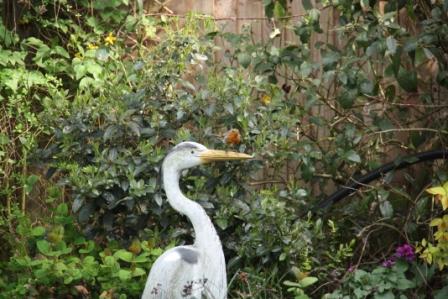
|

|

|

|

|

|

|

|

|

|
Richings Park today ...

Richings Park Garden
of the Tower farms often changed with the name of the tenants. Thorney Farm was known and shown on maps as Fountain's farm as the Fountain family were long standing tenants. Another earlier tenant was Lovejoy. In 1932 it was named on maps as Thorney Farm and in the 1950s it was farmed by the Jolly family. Following the gravel extraction in the 1960s it was farmed by Harold Smith.
When gravel was to be extracted from Thorney Farm in the early 1960s to build the Staines Bypass, an aerial photograph of the site showed interesting crop marks and field systems. At Thorney Farm itself there were a number of very dark rings in the soil which on excavation turned out to be Celtic and later Roman, Romano-British and Saxon storage pits. The most significant discovery was an intact dressed Sarsen stone found in the extracted gravel, with others broken up during the extraction process. These are the material from which Stonehenge is made and are not local deposits. Why these stones were here
can only be guessed, but to the west of this, in the field know as One Hundred Acre Field adjacent to Thorney Lane South, the aerial photo showed a large enclosed area on the 25 metre contour in the shape of a key-hole and some 60 metres in diameter. The lower section opened out with trench markings intersecting the main body. A circular hut around 25 metres in diameter and several smaller huts of 3 to 5 metres appeared to have been present surrounded by a deep ditch, possibly to keep farm animals in and unwelcome wild-life out. Storage pits for grain and root crops were also evident.
Part of the top section to the north east was damaged by the gravel extractions but the rest of the site remained intact following the interventions of archaeologists from the County Museum. In 1967 it was proposed to lay high voltage electricity cables along the boundaries of properties in Thorney Lane South near the Tower Arms. Initially permission was refused because of the importance of the site, but after considerable
debate this was granted provided the trench was as close as possible to the boundaries of the properties and not more than 10 metres wide. Time was not available to carry out a full archaeological investigation so permission was given for Mr Stanley from the County, along with a small group of local experienced enthusiasts, to carry out a controlled dig along the proposed route of the cables.
Because of the limited area available to the dig, only a small part of the site could be investigated, but one of the important discoveries was a deep in-filled ditch which corresponded to the aerial photo and from which a few Stone age implements were recovered, indicating that the land had been farmed for several thousands of years, possibly from around 2,000BC. Small pieces of pottery from both the Bronze and Iron Ages were found in pits and sections and a Bronze Age ring was discovered at the centre of a damaged mound. There may also have been later field systems, indicating that it was

